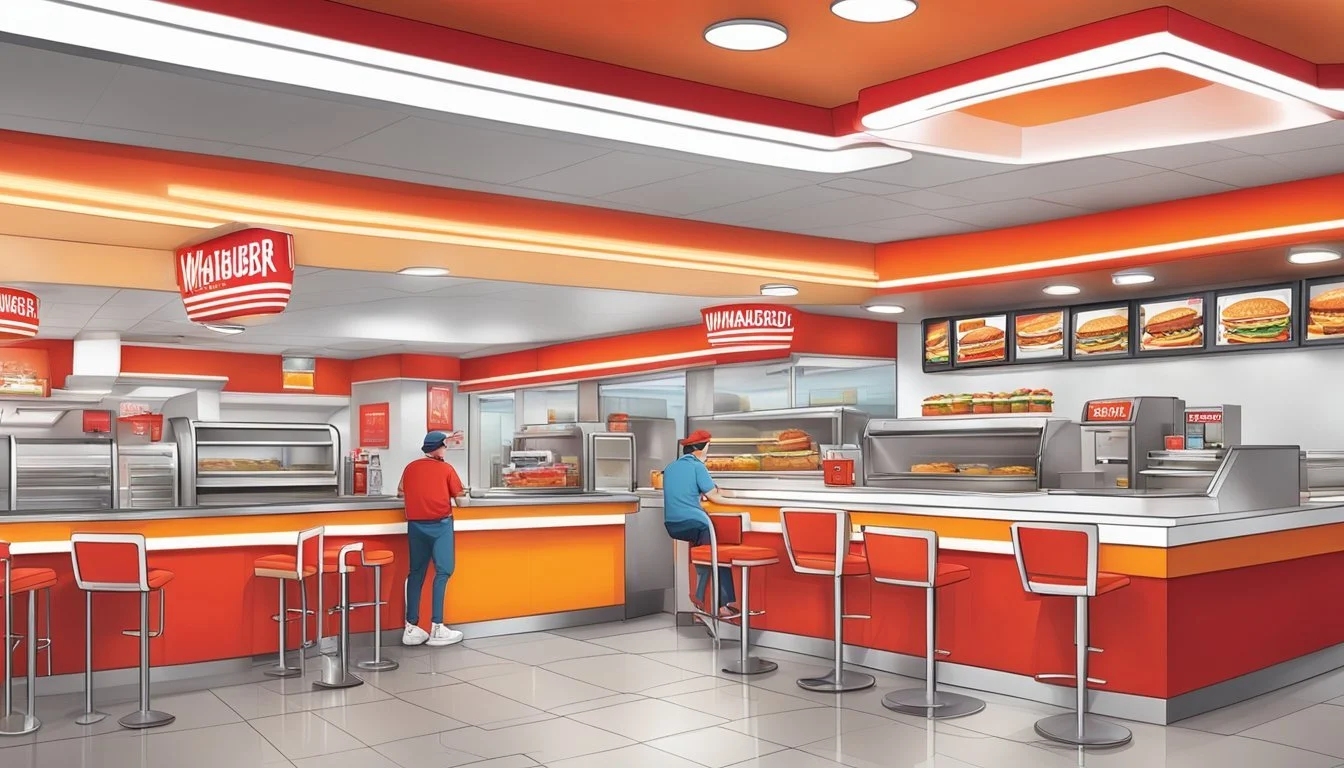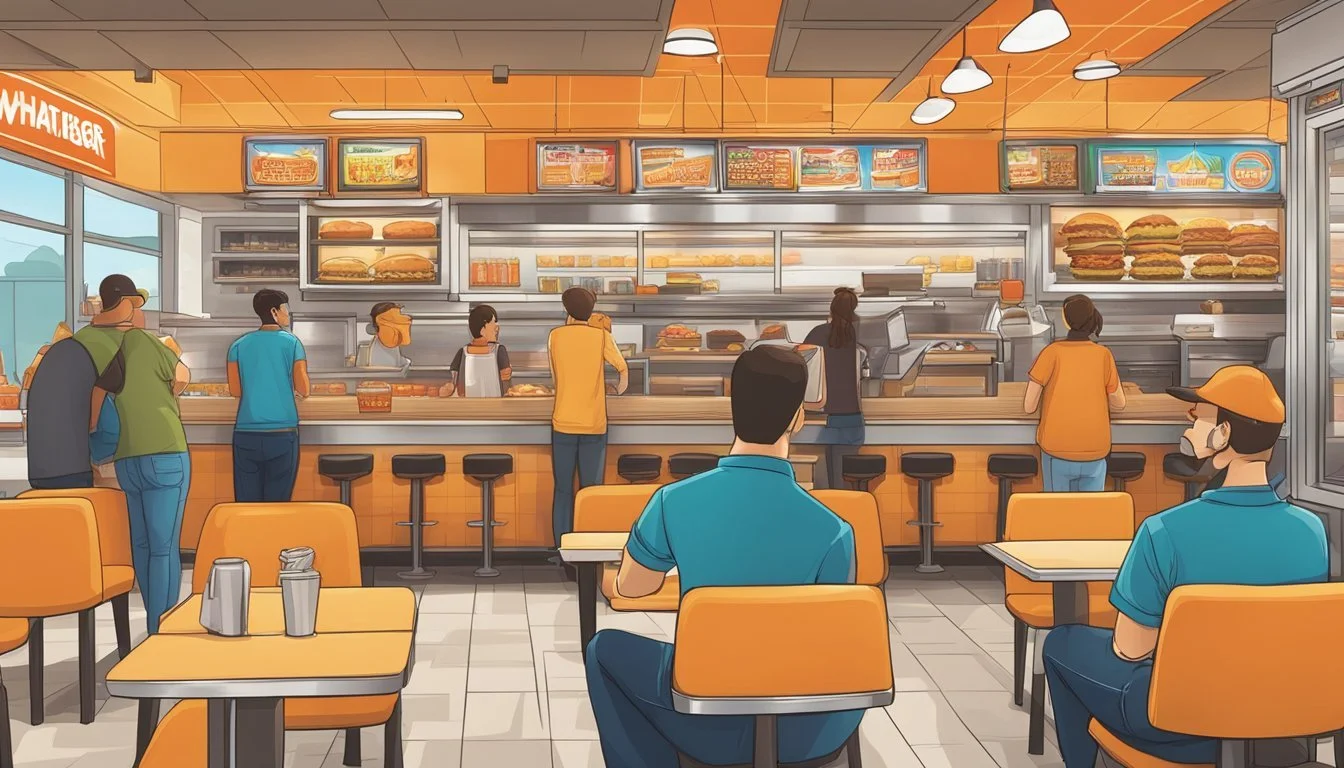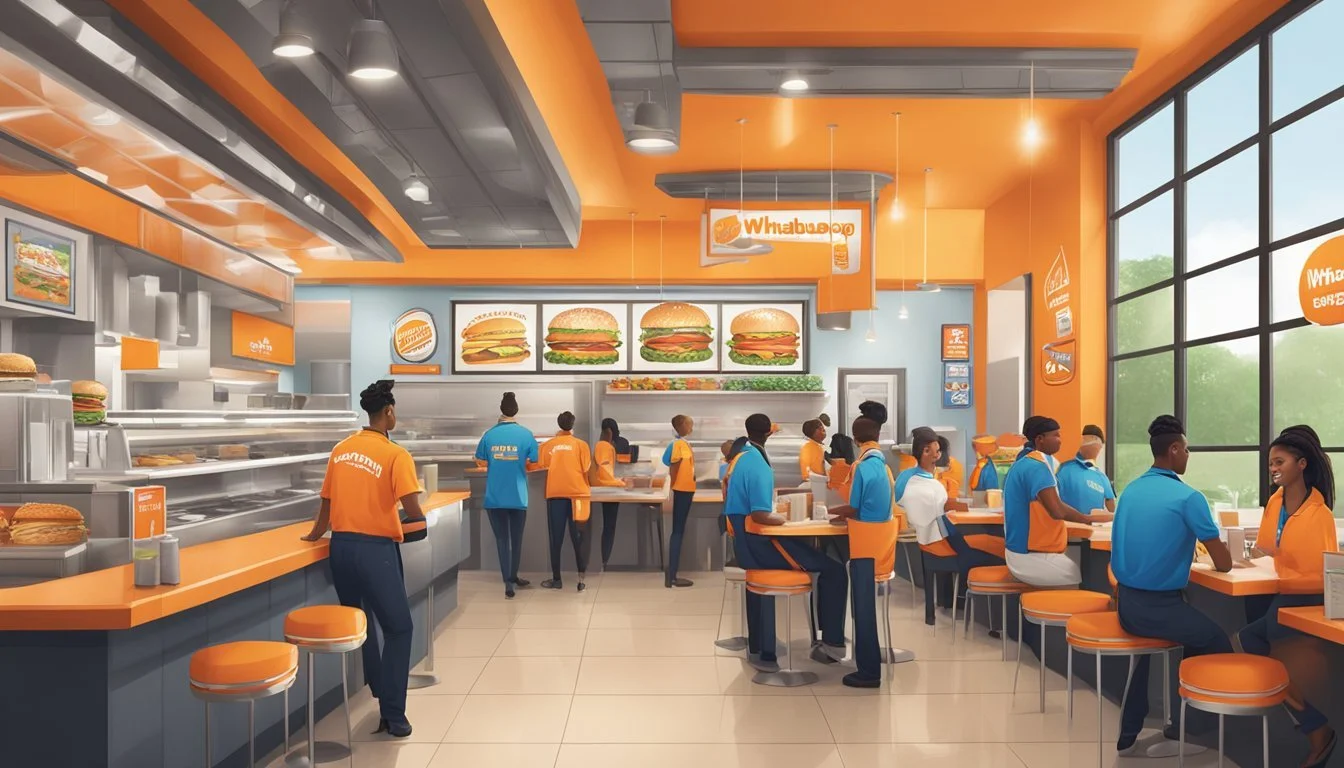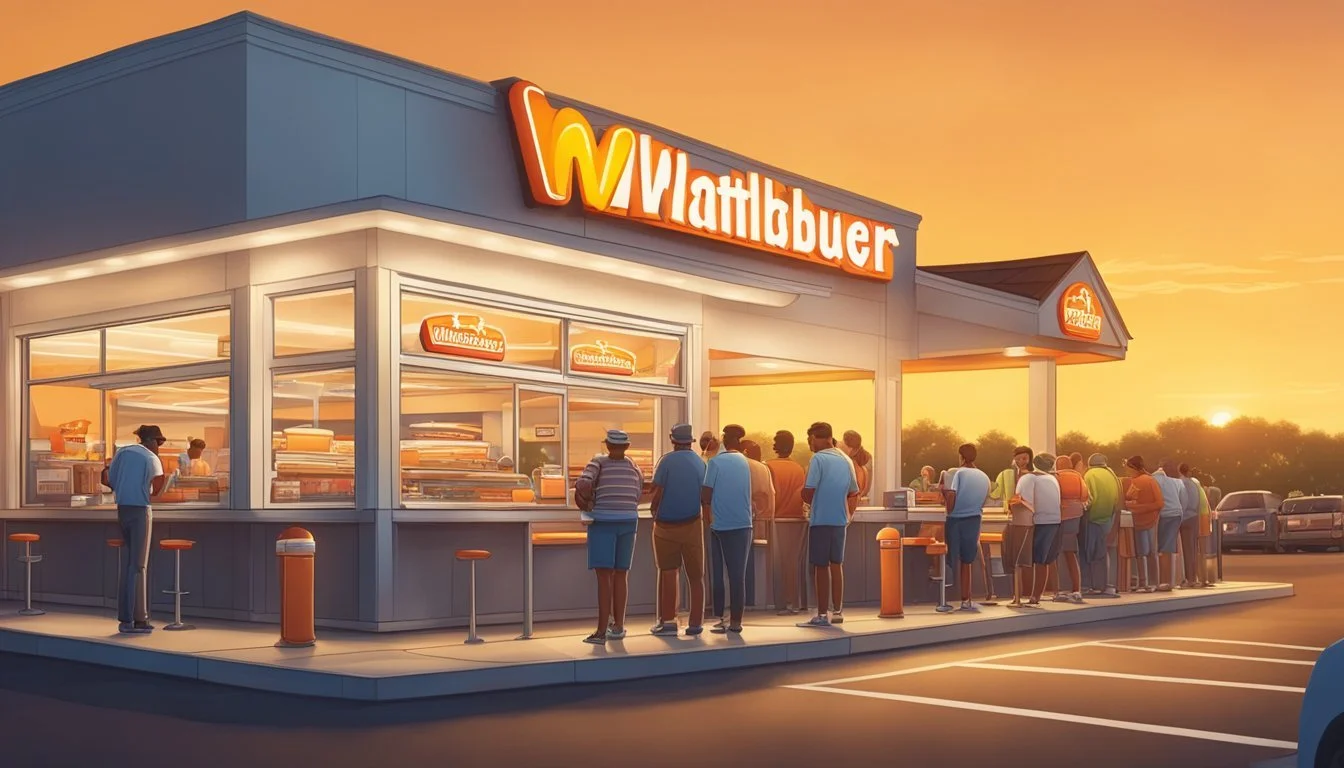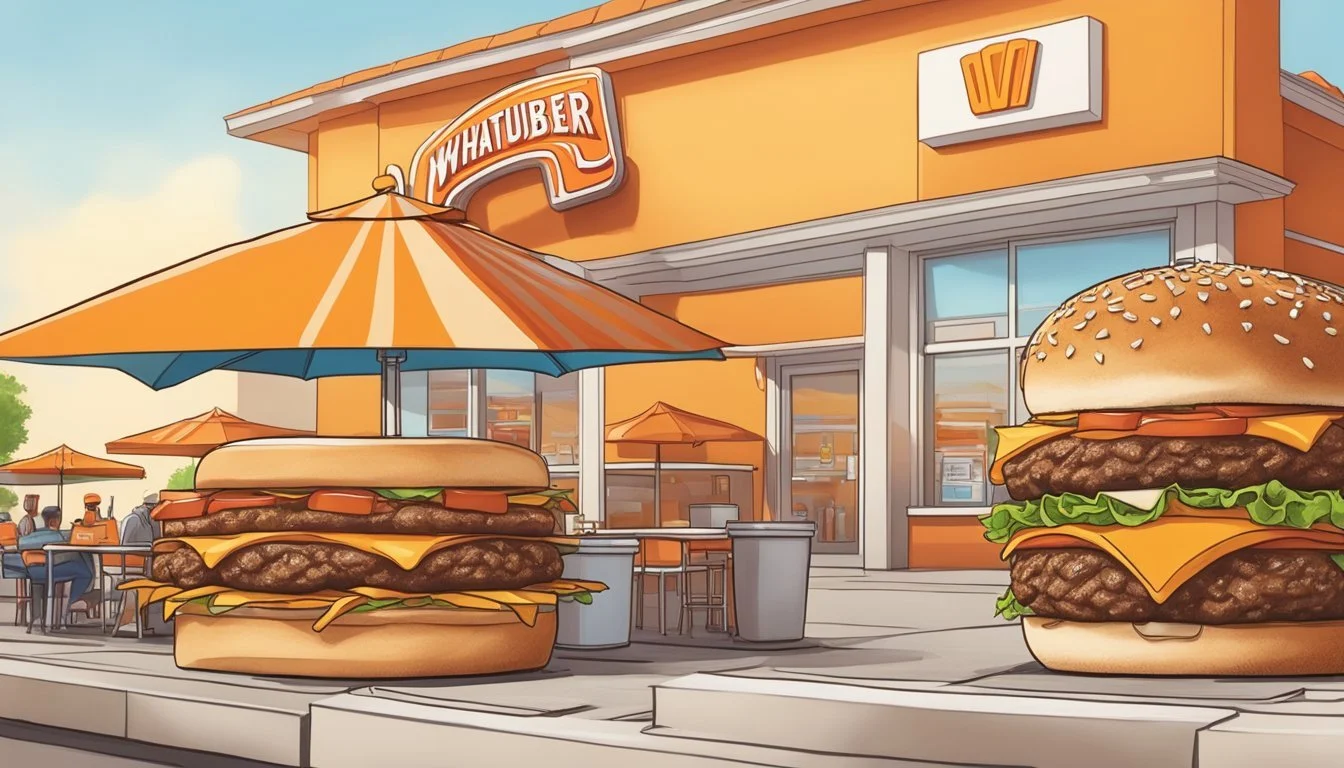Whataburger vs Carl's Jr.
An Unbiased Comparison of Burger Giants
In the competitive landscape of fast food restaurants, burger joints stand out as culinary battlegrounds where brands vie for the loyalty of meat-loving patrons. Whataburger and Carl's Jr. are among the top contenders in this savory showdown. Each restaurant boasts its signature approach to crafting the quintessential American burger, with Whataburger bringing a distinct Texan flair to the table, whereas Carl's Jr. offers up a Californian twist with its premium, charbroiled selections.
Whataburger stakes its reputation on customizability and size, offering customers a range of toppings and a burger that's hearty enough to satisfy even the most robust of appetites. On the other hand, Carl's Jr. prides itself on the quality and variety of its burgers, ranging from the classic Original Six Dollar Thickburger to the more elaborate offerings like the Super Star with Cheese, each aiming to deliver a flavor-rich experience.
While both establishments provide a suite of burger options that appeal to a broad audience, their regional tastes and brand identities play a significant role in shaping the diner's palate. The nuances between each brand's burger, such as the specialized Papa Sauce at Whataburger versus the traditional yet robust condiments at Carl's Jr., have carved out distinct followings and have made the two chains beloved staples in the realm of fast food.
Company History and Brand Overview
The origins and evolution of Whataburger and Carl's Jr. reflect their significant roles in shaping the fast food industry, particularly within the burger chain segment. Each brand has developed a distinctive identity and historical footprint that contrasts their contribution to America's culinary landscape.
Whataburger's History
Whataburger began its journey in 1950, in Corpus Christi, Texas, founded by Harmon Dobson and Paul Burton. They aimed to create a burger so big that customers would say “What a burger!” With this vision, Whataburger has grown to be a notable name, especially in the South, with a significant presence in the burger chain industry. The Texas-based company celebrated a milestone by opening a flagship store in Corpus Christi, marking its upcoming 50th anniversary.
Established: 1950
Founders: Harmon Dobson, Paul Burton
Milestones:
Surpassed the 500-store mark
Known for fresh food and customer service
Sales exceeded $2 billion in 2018
Carl's Jr. Background
Carl's Jr., noted for its expansion along the West Coast, was created nearly a decade before Whataburger, in 1941. Starting with a hot dog cart in Los Angeles, California, founders Carl and Margaret Karcher scaled their operation into a fast-food empire. Carl's Jr. grew rapidly and became known for its charbroiled burgers, eventually merging operations with Hardee's, yet retaining distinct brand identities for both.
Created: 1941
Founders: Carl and Margaret Karcher
Evolution:
Began with a hot dog cart
Recognized for charbroiled hamburgers
Combined branding with Hardee's while maintaining separate identities
Menu Comparison
Whataburger and Carl's Jr. both offer a wide range of burger options and accompaniments, each with its own signature items that appeal to different taste preferences.
Burger Varieties
Whataburger champions a robust menu with various hamburgers and cheeseburgers, all customizable with toppings like mayo, mustard, lettuce, pickles, onions, and tomatoes. Their offerings range from the simple Hamburger to the Whopper and the hefty Bacon & Cheese Whopper.
In contrast, Carl's Jr. stands out with its charbroiled burgers such as the famous Western Bacon Cheeseburger and the larger Super Star with Cheese. Moreover, Carl's Jr. offers the Big Carl, an answer to fans of double-layered beef and cheese.
Signature Offerings
Whataburger is known for its signature Whataburger, a classic staple of the brand, while Carl's Jr.'s notable mention is the Western Bacon Cheeseburger adorned with onion rings and barbecue sauce.
Sides and Beverages
Both joints serve the traditional fast-food fare of crispy French fries which customers often pair with ketchup or their special sauces. Both menus include options like onion rings and a selection of carbonated beverages. Whataburger also provides unique items such as their spicy ketchup, adding a twist to the conventional condiment choice.
Dessert Options
Whataburger offers a simple dessert menu with classics like cookies and hot pies, whereas Carl's Jr. complements its meals with hand-scooped ice cream shakes, a richer sweet treat to end a meal.
Nutritional Value and Quality of Ingredients
When comparing Whataburger and Carl's Jr., it's essential to consider the nutritional content and the quality of ingredients used in their burgers. Both chains offer a variety of burgers that can fit into different dietary preferences, but they also have options that could be considered less health-conscious due to high caloric values.
Caloric Content Comparison
Whataburger
Triple Meat Burger: 1,070 calories
Carl's Jr.
The Really Big Carl: 1,180 calories
Both Whataburger and Carl's Jr. serve up burgers that are high in calories, which could exceed daily caloric needs for some individuals when consumed in their larger portions. For those seeking lighter options, both chains offer smaller burgers that contain fewer calories.
Sourcing of Ingredients
Whataburger boasts fresh, never frozen beef for their patties and touts a selection of vegetables like lettuce, tomatoes, and grilled peppers to be added as toppings. Similarly, Carl's Jr. has focused on sourcing quality beef for their burgers. However, detailed information on the origin of other ingredients for either chain remains less transparent.
Freshness and Preparation
Both Whataburger and Carl's Jr. emphasize the freshness of their ingredients, especially the beef patties which are a staple of their menus. Whataburger highlights customization as a significant value proposition, offering a wide array of toppings from fresh vegetables to various sauces enhaning the consumer's experience.
Each preparation method, be it toasting the buns or grilling the vegetables, aims to fortify the final product's taste. The commitment to fresh preparation aligns with the fast food industry's increasing focus on quality and transparency.
Ambiance and Customer Experience
When customers step into Whataburger or Carl's Jr., they are greeted by distinctly different atmospheres and levels of service that can significantly influence their dining experience. Each brand has cultivated its own environment and processes, from the restaurant décor to the efficiency of the drive-through window, which play a crucial role in a customer's overall satisfaction.
Store Atmosphere
Whataburger offers an aesthetic reminiscent of a traditional American diner. Its restaurants often feature spacious interiors with an orange and white color scheme that communicates a classic fast-food experience. On the other hand, Carl's Jr. presents a slightly more modern look with bolder colors and in some locations, contemporary furnishings, aiming for a trendier fast-food environment.
Service Quality
Service at Whataburger is characterized by a friendly, down-to-earth approach, putting customer satisfaction at the forefront. Their staff tends to ensure that the ordering process is as smooth as possible, both over the counter and through their drive-through windows. Carl's Jr. also aims for high-quality service with an emphasis on quick and efficient order fulfillment, recognizing the customer's need for a swift and convenient experience in today's fast-paced world.
Convenience Factors
Both brands prioritize convenience but approach it differently. Whataburger has a reputation for being open 24/7, catering to customers at any hour, which can be particularly appealing for nightshift workers or late-night cravings. Carl's Jr. has leveraged technology by introducing kiosk ordering in some locations, speeding up the process and reducing wait times. Both chains often feature:
Drive-through windows: Ensuring that customers who cannot or prefer not to come inside can still enjoy their products.
Location spread: Multiple outlets across various states offer ample opportunity for customers to access their services.
In terms of convenience, both restaurants demonstrate their commitment to providing fast and reliable service whether customers choose to dine-in or take out.
Price Points and Value for Money
In the world of fast food, particularly burger joints, consumers often weigh the balance between cost and satisfaction. This section delves into the specifics of pricing strategies and value propositions at Whataburger and Carl's Jr., giving a detailed comparison from a financial perspective.
Cost Comparison
At Whataburger, customers can expect a Whataburger Jr. with Bacon and Cheese for $4.79, and a more substantial double-meat Whataburger Jr. for $3.99. Conversely, Carl's Jr. has items that can be pricier at the high end, with some premium offerings exceeding the average cost when compared to similar fast food items. Without explicit prices for Carl's Jr. items from the given data, one can infer that their higher-end burgers may not align with the budget-friendly options available at Whataburger.
Portion Sizes
Portion size is a key factor when considering value. Whataburger's offerings, such as the double-meat option, suggest a focus on providing a hearty meal at a modest price point. Carl's Jr. is known to offer substantial portion sizes as well, which might justify its higher prices. However, explicit portion sizes are not provided in the search results, preventing a direct comparison.
Combo Deals
Combo deals can enhance the value of fast food purchases. While specific combo deals for Whataburger and Carl's Jr. are not detailed in the search results, such offers typically include a burger, a side such as fries or hash brown sticks, and a drink, often resulting in savings compared to purchasing items separately. Fast food enthusiasts look for these deals to get the most out of their money, making the combo offerings an essential factor in the cost-value equation at any burger joint.
Brand Presence and Marketing Strategies
Whataburger and Carl's Jr. each utilize unique marketing strategies to strengthen their brand presence and appeal to customers. Their methods of advertising, digital engagement, and strategic partnerships distinctly define their respective positions within the competitive burger chain landscape.
Advertising Campaigns
Whataburger has built a strong brand presence through effective advertising by emphasizing quality and tradition. Their campaigns often highlight their longstanding history since 1950 and their expansion from a single hamburger stand in Corpus Christi to a widely recognized chain.
Carl's Jr., on the other hand, is known for its bold and often controversial commercials that are designed to grab attention. They use high-profile personalities and sometimes provocative imagery to differentiate their brand from others like Wendy's and Burger King.
Social Media and Digital Presence
Whataburger leverages its social media channels to connect with customers by sharing relatable content and fostering community engagement. They have utilized Twitter, Facebook, and Instagram effectively to showcase their brand's personality.
Carl's Jr. has also embraced the digital space, utilizing social media platforms to promote new product launches and special promotions. Their digital presence is crafted to align with their edgy advertising strategy, setting them apart from more family-friendly chains such as In-N-Out and Shake Shack.
Sponsorships and Partnerships
Whataburger has engaged in several partnerships that resonate with its Texan roots, such as their collaboration with James Avery for an exclusive jewelry piece and with YETI for a custom stainless steel cup. These partnerships help to cement their brand identity as a Texan icon.
Carl's Jr. has also sought to enhance brand visibility through strategic sponsorships, often within the realm of sports and entertainment, to draw a demographic that aligns with their advertising campaigns. This strategy is similar to that used by large chains like Burger King, which also seeks wide-reaching sponsorship deals.
Customer Loyalty and Brand Affinity
When comparing Whataburger and Carl's Jr., it's essential to examine their loyalty programs and consumer reviews to understand customer loyalty and brand affinity. These factors play pivotal roles in distinguishing which burger chain garners a more faithful customer base.
Loyalty Programs
Whataburger has implemented an effective loyalty rewards app that serves as a catalyst for retaining customers by offering exclusive offers and discounts. Customers appreciate the tangible benefits of their loyalty, which include rewards that incentivize continued patronage.
On the other hand, Carl's Jr. may not have as prominent a loyalty program, but it attracts customers with seasonal promotions and discount coupons. These tactics are designed to bring in repeat business by providing short-term value.
Whataburger Loyalty App:
Exclusive Offers: Customers receive personalized deals.
Discounts: Frequent diners can enjoy reduced prices on favorite items.
Carl's Jr. Promotions:
Seasonal Promotions: Limited-time offers to entice visits.
Coupons: Cost-saving incentives on various menu items.
Consumer Reviews and Ratings
Consumers tend to leave more favorable reviews for Whataburger, citing the quality of their burgers and the customer service as key differentiators. The sentiments expressed in reviews reflect satisfaction with their dining experience, which contributes to a positive brand affinity.
Carl's Jr., while also receiving positive feedback, has mixed reviews that highlight a range of experiences. Consumers often mention the innovative burger options and flavors unique to Carl's Jr., but inconsistency in service and food quality sometimes tempers brand enthusiasm.
Whataburger Consumer Sentiments:
Quality: Often highlighted as superior in reviews.
Service: Regularly praised and associated with a good customer experience.
Carl's Jr. Consumer Sentiments:
Innovation: Acknowledged for unique menu items.
Consistency: Occasionally mentioned as an area for improvement.
Regional Availability and Expansion
Whataburger and Carl's Jr. have unique patterns of availability across the United States, each with distinct plans for growth that reflect their branding and business models.
Market Reach in Different Regions
Whataburger primarily operates in the Southern and Eastern United States, with a significant presence in Texas, where it was founded. As of now, it operates over 900 locations in a 14-state footprint that includes the South and extends into the Midwest. Whataburger's heartland remains in Texas, which serves as a cultural and operational hub.
On the other hand, Carl's Jr. has a strong market reach on the West Coast, particularly in Los Angeles where it originated. It has since spread across various regions and is known for its dual branding with Hardee's in the Midwest and East, although the two maintain distinct menus and identities despite shared corporate ownership.
Whataburger
West Coast: Limited
Los Angeles: None
South East: Extensive
Midwest: Moderate
Carl's Jr.
West Coast: Extensive
Los Angeles: Extensive
South East: Via Hardee's
Midwest: Via Hardee's
Plans for Growth
Whataburger received new investment with the aim to propel its expansion while preserving its historic brand identity. Recent sales figures indicate an ambitious growth trajectory, with plans that seem poised to extend their reach further across existing markets and potentially into new ones.
Carl's Jr., as part of CKE Restaurants, leverages the acquisition of Hardee's to broaden its footprint into new territories, including the East where it could blend with Hardee's presence. Deals and strategic moves point towards a goal of increased national and possibly international presence.
Corporate Social Responsibility and Ethics
When evaluating Whataburger and Carl's Jr., their approach to corporate social responsibility (CSR) and ethical practices plays a significant role in distinguishing the two fast food chains.
Environmental Initiatives
Whataburger has implemented various environmental initiatives aimed at reducing its carbon footprint. These include the use of more sustainable packaging and waste reduction programs. The restaurant also monitors its resource consumption to ensure efficient energy and water use.
Carl's Jr., similarly, has taken steps to address environmental concerns by incorporating energy-efficient kitchen equipment and lighting in their stores. The chain’s commitment to sustainability is also reflected in their efforts to source ingredients from suppliers who practice responsible farming.
Community Engagement
Whataburger prides itself on being actively involved with the communities it serves. The fast-food chain conducts local fundraisers, supports area schools, and participates in charitable events, emphasizing their role as community partners.
Carl's Jr., in comparison, also engages in community service. They have been known to contribute to local charities and national campaigns. Their programs focus on helping those in need and supporting initiatives that benefit the broader society, making community engagement an integral part of their business ethics.
Legal Battles and Controversies
Whataburger and Carl's Jr. are prominent entities in the fast food industry, primarily known for their burger offerings. Over the years, both chains have experienced legal challenges and controversies.
Whataburger, established in 1950, has distinguished itself with a focus on customizable burgers. The chain faced a notable trademark dispute with What-A-Burger, a Virginia-based fast food restaurant established in 1952. The dispute concluded with both parties reaching a coexistence agreement, allowing them to operate under similar names without conflict.
Carl's Jr. has been involved in various controversies, often pertaining to its advertising strategies. The company has historically utilized advertisements that garnered attention for their provocative nature, sparking discussions and, at times, backlash regarding the depiction of women and the overall message being conveyed.
Both companies have faced scrutiny over labor issues. Like many in the fast food sector, they have dealt with lawsuits concerning wage and hour violations, highlighting the industry-wide issue of fair labor practices.
Whataburger
Type of Issue: Trademark disputes
Carl's Jr.
Type of Issue: Controversial advertisements
In summary, Whataburger has navigated legal challenges related to brand identity, while Carl's Jr. has encountered criticism over its marketing campaigns. These incidents contribute to the complex legal and social landscape in which fast food burger chains operate.
Future Outlook and Industry Positioning
In comparing Whataburger and Carl's Jr., both brands are seeking to fortify their positioning within the competitive fast food burger sector. Their industry positioning will be influenced by how they adapt to evolving market trends and customer preferences.
Innovations and Future Menus
Whataburger emphasizes regional preferences, tailoring its menu to the tastes of the Southern United States. It faces the challenge of expanding appeal to a broader audience without compromising its core identity. Innovative menu items targeted at health-conscious consumers and unique flavor profiles could stimulate market growth.
Carl's Jr. is renowned for its bold flavors and variety, offering a range of options that cater to a diverse customer base. This burger chain must continue to innovate to maintain a top spot among burger enthusiasts. Incorporating plant-based alternatives and limited-time offers featuring global cuisines may provide Carl's Jr. an edge in inviting interest and retaining relevance.
Challenges and Prospects
Both chains encounter challenges in expanding market share due to strong competition from top 10 burgers in the global arena. Whataburger's limited regional presence necessitates strategic expansion plans to increase its market share, but it must do so by ensuring consistency in quality across new locations.
Carl's Jr. must confront the saturation of the fast-food industry and differentiate itself from other major players. The focus may shift towards investing in digital innovations and improving customer service experiences to create a more streamlined and personalized customer journey.
Prospects for both chains include leveraging their unique strengths—Whataburger's regional loyalty and Carl's Jr.'s innovative offerings—to foster growth and adapt to the fast-evolving fast-food landscape.
Comparative Analysis
In evaluating Which Burger Joint is Better, this section dissects the specific offerings and standout qualities of Whataburger and Carl's Jr., while drawing comparisons with other renowned fast-food burger establishments.
Whataburger vs Carl's Jr.: Head-to-Head
Menu Variety: Whataburger offers a substantial menu with a range of burgers, including the Mushroom Swiss Burger noted for its caloric heft. Carl's Jr., on the other hand, is known for The Really Big Carl among other innovative options. Both chains provide a selection of toppings and customization that cater to a broad spectrum of tastes.
Taste and Quality: Customers often praise Whataburger for its larger-sized burgers and distinct condiments. Carl's Jr. is recognized for its charbroiled burgers which impart a unique grilled flavor. Their best contender, the Roadside Double, while flavorful with Swiss cheese and caramelized onions, has been critiqued for its messiness.
Health Conscious Options: Fast-food burgers are typically high in calories, but both chains have offerings that are deemed healthier compared to the industry standard. Carl's Jr. has taken strides in offering plant-based alternatives, such as the Beyond Meat patties.
Customer Experience: Both Whataburger and Carl's Jr. boast of quick service and the ability to customize orders which enhance customer satisfaction. However, geographic availability may sway preference; Whataburger is a staple mostly in the Southern and Southwestern United States, whereas Carl's Jr. has a wider presence on the West Coast and in the Midwest.
Comparison with Other Industry Giants
Five Guys: Recognized for its customizable burgers with free toppings, Five Guys stands out for providing fresh, quality ingredients. Its standard hamburger is composed of two patties sandwiched in a toasted bun, allowing a personalized touch with a variety of free toppings.
In-N-Out: In-N-Out maintains a cult following for its simplicity and quality, with a limited menu that focuses on fresh, never-frozen patties. The California-based chain is renowned for its 'secret menu' which allows for an added level of order customization.
Burger King and McDonald's: As international giants, these two chains compete with a vast array of menu items. Burger King's Whopper and McDonald's Big Mac are signature items that have become synonymous with the fast-food burger experience, each with its own set of devoted fans.
In terms of global presence and brand recognition, McDonald's eclipses both Whataburger and Carl's Jr. Meanwhile, Burger King's global footprint and the Whopper's longstanding popularity present formidable competition in terms of market share and consumer preference.
It is the nuances in taste, menu variety, and regional presence that will influence an individual's choice between Whataburger and Carl's Jr., and how they stack up against their rivals in the crowded fast-food landscape.
Conclusion
When choosing between Whataburger and Carl's Jr., burger enthusiasts weigh several factors. Whataburger has carved out a distinct reputation with a loyal following, particularly for its Mushroom Swiss Burger. However, the burger's calorie content, at 1,110 calories, might be a consideration for health-conscious diners.
Carl's Jr. is renowned for its Original Six Dollar Thickburger, with a variety of toppings that add depth to the flavor. Their offerings, like the Really Big Carl, cater to those seeking a substantial, indulgent meal. Both chains have become staples in the fast food scene, often distinguished by their signature sauces and burger constructions.
In terms of fast food burgers, these chains represent the diverse spectrum of American burger culture. Burger chains continuously innovate to meet consumer tastes, and these two are no exception. The decision often comes down to personal preference regarding taste and menu variety. Each brand has its admirers, with Whataburger's unique regional flair contrasting with Carl's Jr.'s widespread burger appeal.
For customers who prioritize taste and variety, each restaurant has its strengths:
Whataburger: Known for flavorful burger options and regional influence
Carl's Jr.: Offers sizable burgers with a broad range of toppings
On occasions, customers base their choices on convenience or specific cravings for a cheeseburger or hamburger. Both burger chains continue to be competitive players in the fast-food market, with distinct strengths that appeal to various consumer preferences.




